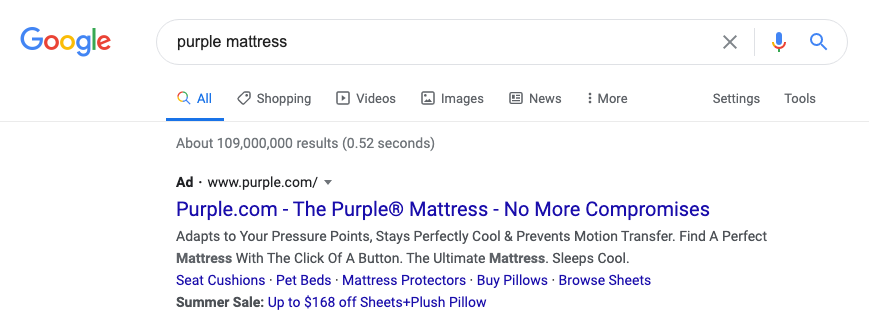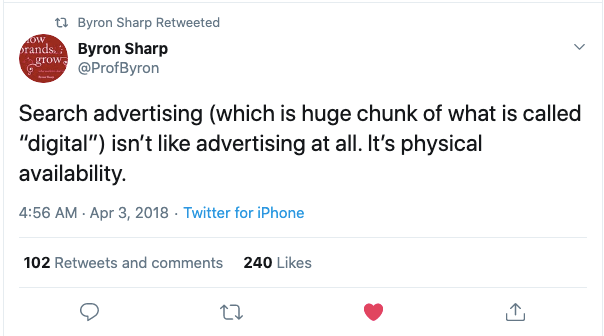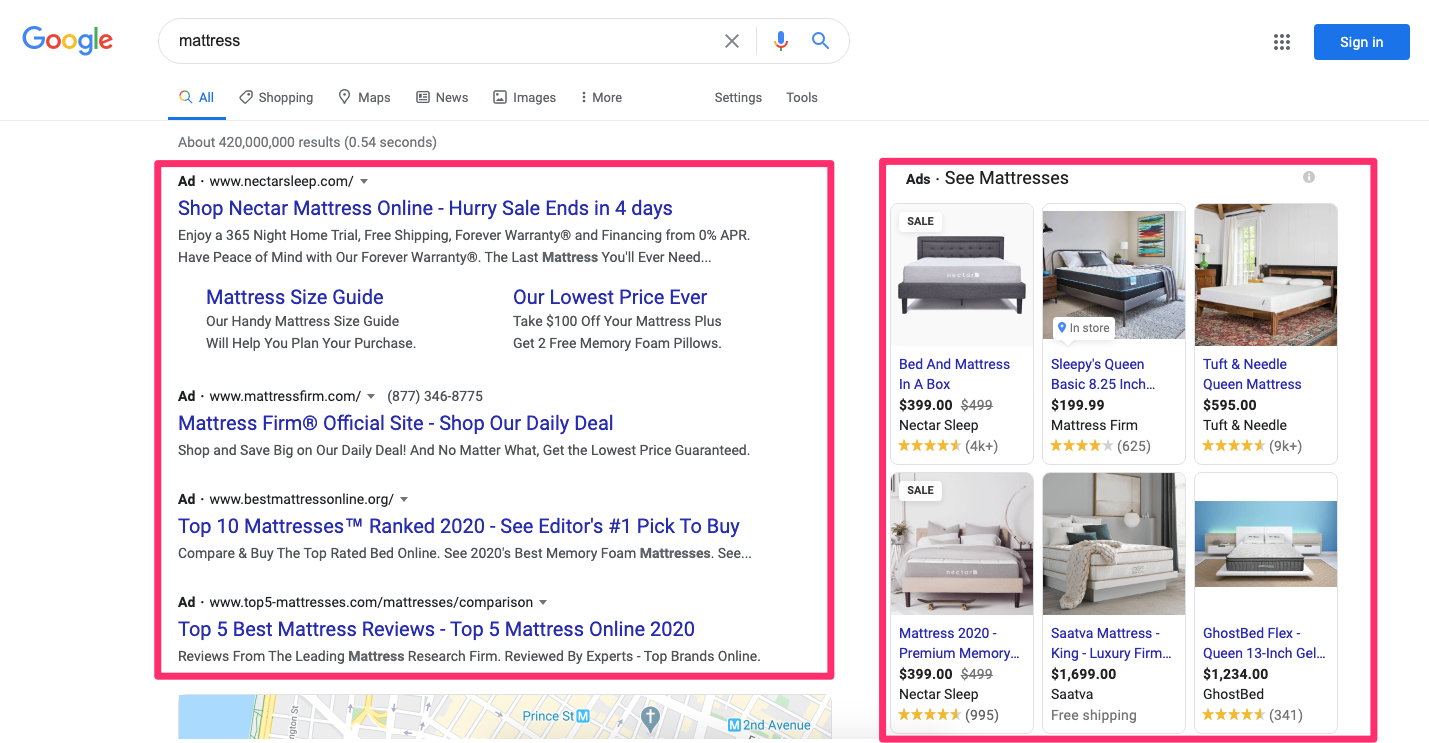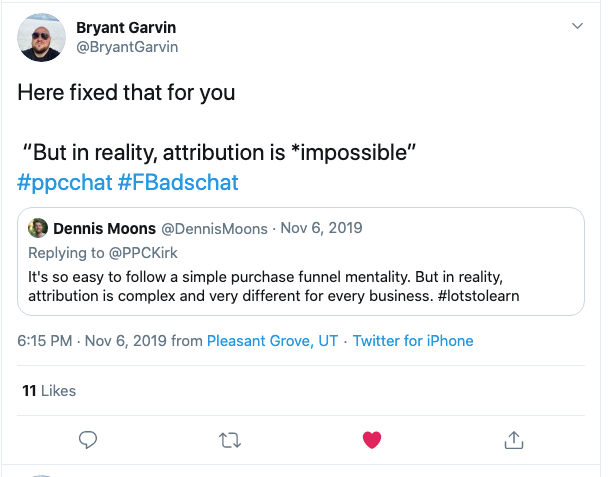In this article, I want to show why most businesses fail to grow their business with Google Ads.
To do so we’ll look at two companies, Purple and Tuft & Needle.
Both companies look pretty similar from the outside: they both sell mattresses online, neither of them raised any VC money and they both acquire customers using Google Ads.
But there is one big difference in how they are using Google Ads.
And understanding that difference can help you save money, sell more, and even lead to a whole new level of growth.
Let’s dive in!
Branded Search: The Holy Grail Of Ecommerce
The ideal scenario for an ecommerce business is that new customers find you.
They search for your brand and click your organic listing or ad.
And because they already know who you are, these visitors convert pretty well. When it comes to Google Ads, these often are the cheapest and most profitable campaigns.
Take this Search Ad by Purple:
It’s no surprise that every ecommerce brand would like more searches like this.
But it’s less obvious how to accomplish that.
Looking at how businesses try to do this, there are two different approaches: the Harvesters and the Seeders.
The Harvesters
Most companies are Harvesters:
A Harvester tries to harvest the demand that has been created in some other way.
Maybe this happened through their own efforts, maybe through someone else’s.
Another way to think about this is to imagine what happened BEFORE someone searches on Google.
Did they see a poster at a bus stop? Or did a friend tell them about a new drink? Read a blog post on the benefits of turmeric?
And now they’re ready to take the next step with a Google Search.
While your company might not have anything to do with the steps before, you might have a solution for the person searching.
I like how Byron Sharp, author of the amazing book “How Brands Grow“, puts it:
Physical availability means that you are present when a customer is ready to buy.
So your Search and Shopping Ads work like a digital shelf, they sit there in case someone needs that solution.
Tuft & Needle is a Harvester. Take for example this search results for the search query “mattress”:
They don’t really care why people are searching for a mattress. All they need to do now is show up and try to capture that click.
The Challenges For Harvesters
The main problem of being a Harvester becomes clear from the screenshot above.
There are 4 Search Ads and 6 Shopping Ads. So the chances of getting the click are slim.
All you can try is to do a little better as your competitors:
- Optimize your campaigns slightly better (to get cheaper clicks)
- Have a website that converts more visitors
- A repeat purchasing machine that turns one-time buyers into loyal ones.
The more items in this list you get good at, the more of the demand you can capture. That is because number #2 & #3 influence your CPA (cost per acquisition), if you have a better website and more repeat purchasers, you can afford to spend more to acquire that customer.
This is the theory. The reality is more sobering.
If you’ve done the basic optimizations, you’re not going to shave 50% off your CPCs. Improvements in the conversion rate or repurchase rate take a lot of work and investment.
So there is a clear ceiling to how much traffic you can profitably convert. And usually that ceiling is a lot lower than you’d like to.
Long term growth
Apart from search traffic that you’re unable to capture, there is also a problem that hurts your long term growth.
When you stop advertising, sales quickly fizzle out.
There is little (or no) longer term effect of unbranded paid search . Because you doesn’t build up brand awareness, potential customers won’t actively seek you out (= branded search).
So what can we do? What else is there?
The Seeders
The second type of businesses are the Seeders
A Seeder is a business that invests into creating the demand for their own brand and products.
This brings us to the realm of brand building. Think Mad Men, billboards, TV commercials, magazine ads, and banner ads. But also YouTube Ads, Facebook Ads, email marketing, or even branded packaging.
While the first group of tactics might still work, it’s too far out of my wheelhouse to comment to its effectiveness. But that second group feels a lot closer to home.
So let’s take a look at an example of a modern brand that does this well, Purple Mattresses.
In my analysis of the brand, I found the following:
In a presentation, Purple said that their branded (non-RLSA) campaigns are responsible for 85% of the impressions and 80% of the clicks on their branded campaigns.
In other words: 80% of people searching for “purple” or related terms have never been on their site.
The driver behind all those searches were YouTube ads:
The overall strategy was that if they would make sure they were top of mind, people would pick them when it came time to purchase a mattress.
The above sentence shows the difference with the Harvester approach:
- Become top of mind
- Have the customers seek you out when the time comes to purchase
These aren’t very easy to track though.
Becoming better at attribution could have an answer to #2, but the interplay of different channels, devices and time lag makes it impossible.
Bryant Garvin, the architect behind the Purple strategies agrees:
So if it is so hard to track, how did they know they were successful?
Starting out, they simply measured money in vs money out.
Today this is probably more complex, but at the start, their ads were literally the only way that people could find out about the brand. So growth couldn’t have happened any other way.
If we take a look at the growth of brand awareness of Purple vs other mattress brands, it’s clear that they were growing ALOT faster.
Compare that line to the one of Tuft & Needle, our example of a Harvester. Their brand awareness also goes up, but much slower compared to Purple.
What’s also interesting from this chart is the comparison with Casper, which seems to have grown at a slightly slower pace starting out.
You can’t see it from this graph, but Purple did all of that growth by relying on the revenue it generated. While Capser raised $340M in venture capital to grow SLOWER.
Should We All Become Seeders?
If it is so obvious that this works, why aren’t more businesses following suit?
That’s because it is very hard to pull this off. that’s mainly because of talent and patience.
Most Google Ads experts are great at Harvester skills: testing, optimizing, analyzing and automating.
But to pull to build brand awareness requires a different set of skills is required: creativity, branding, and storytelling. These are offered by a different type of service provider, people like brand experts or creative directors.
Getting these people involved requires an up-front investment that can be quite scary.
For Purple, that investment meant spending $500,000 on creative assets (ads with different intros, ending, text, CTAs, etc). And backing that up with a media budget in the range of $100k-1M before they were able to generate a return.
It might be possible to do this on a smaller scale, but it will require more creativity.
But no matter what budget you’re working with, it requires patience to wait for the pay off to come.
And if you do manage to crack that code and find a way to drive demand, you have a pretty good moat to protect you against competitors.
While they are fighting amongst each other on who gets the $4 “mattress” click, you’re cashing in on your $0.02/click “purple” search queries 🤑
What’s Next?
I’ve found it fascinating to think about the difference between the two company types and the bigger implications.
For most of my career, I’ve been helping businesses with the Harvesting part. And because that’s what I know, that’s immediately where my mind goes.
I’ve neglected the opportunity to steer companies to Seeder type of activities. But I’ve started to discuss these concept with a few clients, and it’s leading to interesting ideas.
I’ve also realized that this doesn’t make sense for all clients, and not all clients want to invest in this.
But the potential upside of this is huge, on or off the Google Ads platform. Because if you can get this right, there are all kinds of synergies with other marketing activities.
Thanks to Herik Mourão for reviewing a draft of this article.





